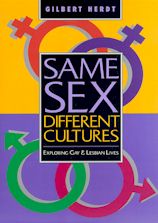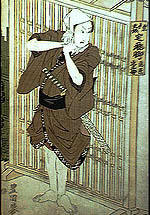 |

 |
|
By Gilbert Herdt Same Sex, Different Cultures, by Gilbert Herdt, Westview Press, 1997, 204 pages, $20 pages; $23.00.  Scholars who believe that sexual identities such as 'gay' and 'straight' are socially constructed have long used case studies from different cultures around the world to bolster their arguments. Rarely, however, do the anthropologists conducting that research venture into the realm where politics meets sexual theory. Gilbert Herdt takes on this daunting task in his book Same Sex, Different Cultures.
Scholars who believe that sexual identities such as 'gay' and 'straight' are socially constructed have long used case studies from different cultures around the world to bolster their arguments. Rarely, however, do the anthropologists conducting that research venture into the realm where politics meets sexual theory. Gilbert Herdt takes on this daunting task in his book Same Sex, Different Cultures. The author draws heavily upon his own anthropological background in discussing several of the pressing issues of the day involving queer studies. Herdt, who identifies himself as a social constructionist, states that the main purpose of his book is to "reclaim the 'lost' and 'invisible' lives of gays and lesbians hidden from society and hidden from history."(ix) Same Sex, Different Cultures attempts to do much more than that, however. Herdt uses his knowledge of the diversity of sexual expression to take on homophobes and heterosexists directly and challenge many of their major assumptions. Here lies a significant problem with the book. Herdt seemingly tosses in everything but the kitchen sink in attempting to prove his main point that same-sex relationships have existed in all the parts of the world. In trying to make his case, Herdt wanders from topics as diverse as the sexual positive culture of Thailand to a heavy discourse on the origins of homophobia, which reads like a transcript from a graduate seminar in queer theory. Simply put, this is not the ideal book for beginners to gender studies.
"A sexual identity implies a system of preferences based on morally laden cultural ideas and emotions of what is valued and desired by the society as a whole." Herdt is best when he focuses on the many cultures that have tolerated or even promoted same-sex love. By doing so, he effectively demonstrates that there are many ways to view sexuality other than through the rigid western perspective. In the "Sambia" culture of Melanesia, for example, Herdt explains that it is believed that boys can only become a man through insemination by an adult male. This may seem absurd at first to a westerner who is unfamiliar with the practice, but makes perfect sense when explained by Herdt. Same Sex, Different Cultures is extremely successful at demonstrating, through over a dozen short descriptions of the habits of various cultural groups, that all sexual categories and gender roles are artificial constructs. Its results are mixed when the book tries to tackle more specific policy issues. Herdt is quick to drop any notions of impartiality and actively advocates solutions for many of the major problems facing gays and lesbians today. His pleas for greater efforts to discover a cure for AIDS, for example, do not seem to have much to do with the stated main goal of his book. This is not to say that nothing can be drawn out from Herdt's book and applied to today's problems. Many of the author's suggestions and criticisms are quite helpful. For example, his description of "Coming Out" ceremonies is right on. "Why people who desire the same gender require a ritual when others in our society do not is painfully clear. Ritual is necessary because of the negative images, stigma, and intense social contamination that continue to exist in the stereotypes and antihomosexual laws of our society." (111) He also stresses that people need a community when they come out. Herdt makes it crystal clear that he is on the side of those people who stray from America's rigid sexual norms. This approach has both its benefits and drawbacks. The book gains in the sense that the author is open about his agenda and compelling in his desire to alleviate what he perceives as centuries of western repression of completely natural sexual practices. On the other hand, Herdt risks calling into question his scholarship by taking sides so completely over such controversial issues.
 While Same Sex, Different Cultures is not perfect -- the author tries to extrapolate too much out of his anthropological topic base -- this reviewer is willing to give him the benefit of the doubt since Herdt's intentions are obviously noble.
While Same Sex, Different Cultures is not perfect -- the author tries to extrapolate too much out of his anthropological topic base -- this reviewer is willing to give him the benefit of the doubt since Herdt's intentions are obviously noble.
The most significant contribution of Same Sex, Different Cultures remains its overview of sexual construction throughout the ages and across the world. Herdt more than makes his point that our western notions about gender and sex are by no means universal. Those interested in learning more about he queer past and what lessons it may hold for today would be well advised to consult this ambitious work.
Erik A. Sanjuro is a graduate student in political science at the University of Southern California. His specialty areas are in American Government and Political Communication. |

© 1997-99 BEI